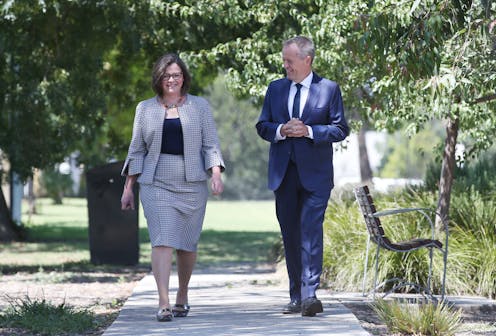Ged Kearney’s candidacy shows the relationship between Labor and the unions remains mutually beneficial
- Written by Ray Markey, Emeritus Professor, Macquarie University

Former Australian Council of Trade Unions (ACTU) president Ged Kearney is facing an uphill battle to retain the federal seat of Batman for Labor at Saturday’s byelection. While ACTU officials entering parliament as Labor MPs is a well-trodden career path, Kearney’s predecessors usually stood for safe seats.
Read more: Politics podcast: the Batman byelection battleground
Bob Hawke (who was ACTU president between 1969 and 1980) became Labor leader and prime minister in 1983. Simon Crean (president 1985-90), Martin Ferguson (president 1990-96), Jennie George (president 1996-2000), and Greg Combet (secretary 2000-07) all left the ACTU for parliamentary careers.
Almost half of Labor MPs generally have had union connections, and many have been senior union leaders at state or federal level. The Liberal and National parties routinely argue the career path from senior union leader to parliament demonstrates how much the unions influence the Labor Party.
There are undoubtedly advantages for unions in terms of access and policy influence by having former officials as MPs. However, this influence can be overestimated. Unions frequently complain that former officials develop broader perspectives in parliament, because the party needs to balance competing political and community interests to be effective in government.
Read more: How the influence of trade unions on the Labor Party is overestimated
What it means for Labor
It is often claimed that the influence runs from party to the unions through former union officials, rather than vice versa. This leads to a moderation of union demands.
This process may be exacerbated by MPs now rarely coming through union ranks. Many are in fact political appointments to unions before becoming staffers for ministers and then entering parliament.
Nor do former union officials vote as a bloc within the Labor Party’s internal deliberations. As with other MPs, they usually align with one of the competing party factions.
Generally, the parliamentary Labor Party benefits from recruitment of senior union officials. ACTU leaders have already developed a high profile in the community, and to that extent test their potential electoral appeal.
If they lack public appeal they are unlikely to become parliamentary candidates. But if they do, they are likely to have a short career as ACTU leader regardless: success in that position is highly politicised and requires significant media skills.
Kearney’s effective media presence fits this general profile, if not quite to the same extent as Hawke’s legendary media skills and broad public appeal he built before entering parliament and successfully leading the Labor Party into the 1983 election.
Another advantage for Labor is that senior union officials undoubtedly represent an injection of talent into the parliamentary ranks.
Apart from media profiles, they are already experienced in dealing with a range of complex policy issues and in managing a variety of perspectives within the union movement and beyond.
An indication of this talent is that all bar one of the ACTU leaders who entered parliament soon took on ministerial positions. The exception – George – was hindered by factors other than a lack of talent.
What it means for the unions
Labor’s gain does not necessarily represent a loss for the unions.
All the ACTU leaders who entered parliament held union office for reasonably substantial terms. A regular turnover of leaders represents a positive trend in democratic organisations; it also allows the development of new talent within the union movement.
There do not appear to have been any major problems in the ACTU with gaining adequately qualified replacements for those entering parliament.
Finally, there is the issue of representativeness of union leaders in the broader community given the decline in union membership in recent years. ACTU leaders are representative of unions as a whole, since virtually all are affiliated to the ACTU. But total union membership now barely exceeds 1.5 million. Unions represent only 10% of private sector workers and 39% of the public sector.
Nevertheless, unions remain Australia’s largest representative civic institutions. Their membership exceeds those who regularly attend religious services of any denomination, and is almost double the number of small business owners who employ workers. And unions collectively represent 59% of the workforce in bargaining for conditions through enterprise agreements or awards.
Surveys also show 20% of non-unionists would join unions if they had the opportunity; 60% believe unions are important for working people; and almost half believe workers would be better off if unions were stronger.
ACTU leaders like Kearney, therefore, potentially reach a large audience in the electorate.
Authors: Ray Markey, Emeritus Professor, Macquarie University





